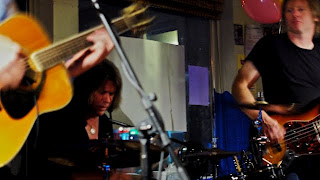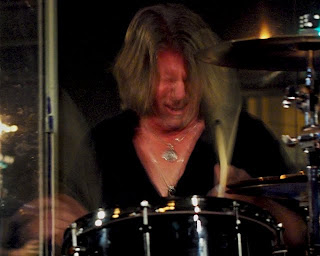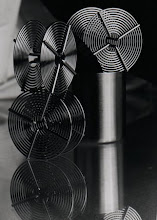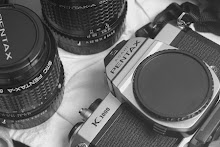
Vivid colors captured indoors with a simple white balance adjustment.
by John O'Keefe-Odom
AgXphoto.info
Subjects can really twist your arm sometimes. This last bunch, a rock band, forced me to overcome obstacles and challenge my wits by making me face one of the greatest photographic difficulties of all time: photographing the band, while they were inside a bar packed with cold beer and good looking women.
I had to take several breaks.
Dutifully, I managed to get some pictures. Of the band.
I travelled light with two lenses; I believe I ended up using a 645 55mm at f/2.8 most of the time. It would come in around 70mm on the DSLR, with a horizontal angle of view similar to a 100mm.
The second lens got out of the bag long enough for an angle of view check. It went right back in the bag. I only needed one lens.
A quick exposure check showed that 400 ISO wasn't going to cut it, unless I was willing to break out the flash. I was planning on firing up the scene with Ye Olde Vivitar 285, but the stage was lit pretty well by the house lights. I scrapped my plan, and moved to catch what was there.
Pumped up to ISO 1600, I was skeptical. Yet, as soon as I slapped on the Tungsten white balance adjustment, I knew I was in. Vivid colors filled the files. I knew I would pick up a lot of motion blur, with common shutter speeds at 1/6; but since my subjects were in motion, well, why not?
As with many motion blur photographs, motion within a portion of the frame is often acceptable, if it's part of the story. Motion in the subject works. Motion from camera shake doesn't. Use your judgement.
 While it's tempting to focus on the lead singer of that rock'n'roll band, there's a whole band! Photograph the other musicians! This band had plenty of interaction; they played their music together. That's part of the story. If it was all about the frontman, by himself, he'd be a soloist. The show is put on by a band. They're a group of people. Photograph the whole group, sections of the group, individuals, people and objects; what is that band doing? The whole band.
While it's tempting to focus on the lead singer of that rock'n'roll band, there's a whole band! Photograph the other musicians! This band had plenty of interaction; they played their music together. That's part of the story. If it was all about the frontman, by himself, he'd be a soloist. The show is put on by a band. They're a group of people. Photograph the whole group, sections of the group, individuals, people and objects; what is that band doing? The whole band. Since they're all playing, they all count. If I had directed my attention only to the lead singer, I would have come back with about 25% of what I photographed that night. Get photographs of the whole band.
 If subject motion blur is part of the story, let it roll. Why fight it? These streaks were caused by movement faster than 1/6 of a second. If the subject is moving that fast, why not show that motion? Let them draw with the light sometimes.
If subject motion blur is part of the story, let it roll. Why fight it? These streaks were caused by movement faster than 1/6 of a second. If the subject is moving that fast, why not show that motion? Let them draw with the light sometimes. Here's a classic problem with people and instruments or tools: how are we going to capture them, and get it all in? My answer: don't get it all in. Focus on a subject for the frame of the photo. It's really not that different from how we might photograph people in other instances. For example, when was the last time we insisted on photographing someone from below their shoes to above their head, all the time? Full length portraits happen, but we're often willing to make photos at 3/4 or tighter, if that tells our story.
Here's a classic problem with people and instruments or tools: how are we going to capture them, and get it all in? My answer: don't get it all in. Focus on a subject for the frame of the photo. It's really not that different from how we might photograph people in other instances. For example, when was the last time we insisted on photographing someone from below their shoes to above their head, all the time? Full length portraits happen, but we're often willing to make photos at 3/4 or tighter, if that tells our story. In the case of musical instruments or other large objects people hold and use, why feel pressed to show the whole thing? Cut the frame of the photo so that it has a clear subject. If you're getting it all in to have a nice, overall view; then it had better be a great enough view to displace the concept of a subject in a photograph.
Get a subject. It helps.
Don't stop the rock. If you grab a lot of motion while catching motion, go ahead and use it. This bass guitarist sprang into a bold pose for about half a second, and then hopped back into a traditional stance for most of the rest of the show. It was a one-time capture of stage attitude. Catch it if you can. The motion blur is part of the story.








No comments:
Post a Comment